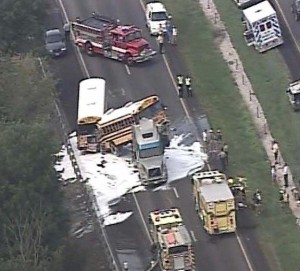
Crashes, such as this one blamed on distracted driving, take an enormous human and economic toll, a new NHTSA study underscores.
Roadway crashes are responsible for more than 30,000 annual deaths – they are, in fact, the leading cause of death for Americans under the age of 34. But they also pose a serious economic burden for everyone living in the U.S.
A new federal study found that crashes cost the country $871 billion in in 2010. In terms of just the economic cost, a total of $277 billion, that works out to nearly $900 for every man, woman and child living in the United States. The National Highway Traffic Safety Administration study estimated that so-called societal harm, in terms of the damage done through loss of life, pain and injury, was more than twice as high, at an average $594 billion.
“No amount of money can replace the life of a loved one, or stem the suffering associated with motor vehicle crashes,” U.S. Transportation Secretary Anthony Foxx said. “While the economic and societal costs of crashes are staggering, today’s report clearly demonstrates that investments in safety are worth every penny used to reduce the frequency and severity of these tragic events.”
The once-a-decade study looked at the year 2010, when 32,999 people were killed on U.S. roads, including both drivers and passengers, as well as pedestrians. Another 3.9 million were injured, while 24 million vehicles were damaged. The death toll has actually been dropping sharply in recent decades, from a peak of more than 50,000, but the new NHTSA study makes it readily apparent that the impact of highway crashes must be measured in both financial and human terms.
Significantly, the study, dubbed “The Economic and Society Impact of Motor Vehicle Crashes, 2010,” focuses on three behaviors that it contends are responsible for more than half of the economic losses and almost two-thirds of the societal harm experienced as a result of crashes:
While drunk driving is often cited as one of the country’s most serious highway problems, the study actually listed speeding as a more significant issue, responsible for 21% of the total economic losses, or $59 billion, and 24% of societal harm, o $210 billion.
(Death toll from GM defect expected to rise. To see more, Click Here.)
Law enforcement authorities have engaged in aggressive crackdowns on drunken driving in recent years, one of the main reasons, experts contend, that the highway death toll has declined. Nonetheless, drivers who were under the influence of alcohol caused crashes generating 18% of the economic losses in 2010, at a cost of $49 billion. In terms of societal harm, DUI and DWI crashes were a factor in 23% of the losses, or $199 billion.
(Recalls already nearing an all-time high in US as Ford announces 4 new ones covering 1.4 million vehicles. Click Here for the latest.)
Distracted driving is the other big problem, according to the NHTSA study, responsible for 17% of total economic losses, or $46 billion, as well as 15% of societal harm, or $129 billion. NHTSA officials have previously suggested that roughly 10% of the annual highway death toll can be blamed on distracted driving, a problem some experts believe is actually getting worse – despite new laws – due to such problems as texting while driving.
NHTSA’s Acting Director David Friedman noted that much of the annual carnage – in terms of both human and economic losses – could be prevented. And one of the simplest steps would be to have more American buckle up. More than 10% of those killed in 2010 might have survived – 3,350 people, in all – had they been wearing seatbelts, the study showed, while another 54,300 were unnecessarily injured.
“Seat belt non-use represents an enormous lost opportunity for injury prevention,” the report noted.
(GM expected to see a flood of additional recalls this year. Click Here to find out why.)
The latest data from NHTSA indicates only about 87% of Americans wear belts while driving or riding as passengers. The figure has been stuck in the 80% range for a number of years, and is far less than in a number of other industrialized nations, global studies indicate.
General Motors, which has a number of safety problems of its own, recently announced it will offer an optional seatbelt interlock system on several models sold to fleets starting with the 2015 model-year. The device will not let a vehicle be driven if any front seat occupant is not buckled up. NHTSA tried to mandate seatbelt interlocks in the 1970s but ran into stiff consumer resistance.
(Click Morefor more on the new GM seatbelt interlock system.)

Much of the carnage and cost could be prevented with proper driver skill requirements to obtain a driver’s license. States however are more interested in revenue than safety.
24 million vehicles were damaged is too high. It cannot be right. There is probably 240 million vehicles and 10% damage seem high(1 in 10 people that you meet. Should be somthing like 1 in 30 or lower). Check your data again.
That was the number they released in their study, John.
Paul E.